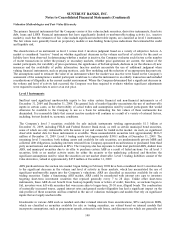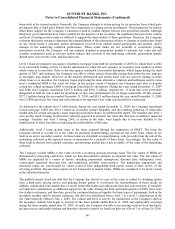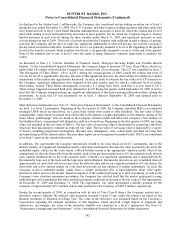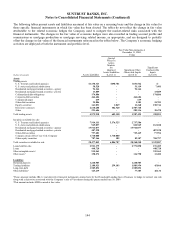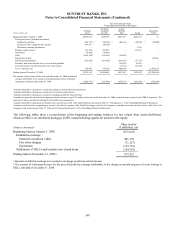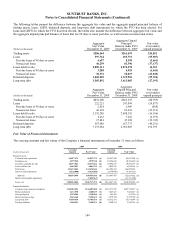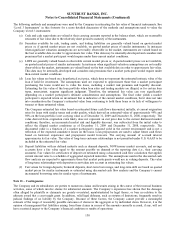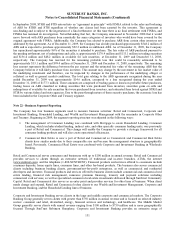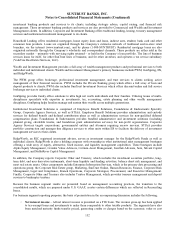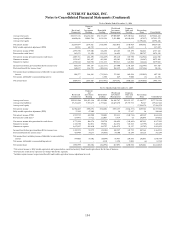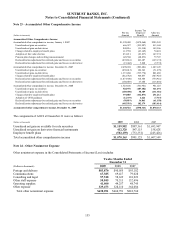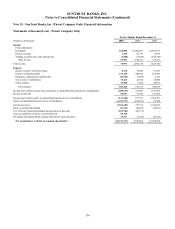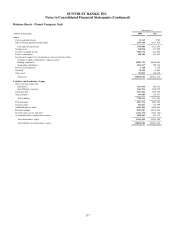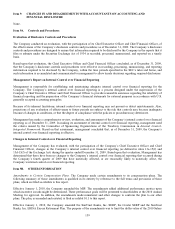SunTrust 2009 Annual Report Download - page 166
Download and view the complete annual report
Please find page 166 of the 2009 SunTrust annual report below. You can navigate through the pages in the report by either clicking on the pages listed below, or by using the keyword search tool below to find specific information within the annual report.SUNTRUST BANKS, INC.
Notes to Consolidated Financial Statements (Continued)
The following methods and assumptions were used by the Company in estimating the fair value of financial instruments. See
“Level 3 Instruments” in this footnote for a more detailed discussion of the methods and assumptions used to value the
Company’s level 3 instruments:
(a) Cash and cash equivalents are valued at their carrying amounts reported in the balance sheet, which are reasonable
estimates of fair value due to the relatively short period to maturity of the instruments.
(b) Securities available for sale, trading assets, and trading liabilities are generally valued based on quoted market
prices or, if quoted market prices are not available, on quoted market prices of similar instruments. In instances
when significant valuation assumptions are not readily observable in the market, instruments are valued based on
the best available data in order to approximate fair value. This data may be internally-developed and considers risk
premiums that a market participant would require under then-current market conditions.
(c) LHFS are generally valued based on observable current market prices or, if quoted market prices are not available,
on quoted market prices of similar instruments. In instances when significant valuation assumptions are not readily
observable in the market, instruments are valued based on the best available data in order to approximate fair value.
This data may be internally-developed and considers risk premiums that a market participant would require under
then-current market conditions.
(d) Loan fair values are based on a hypothetical exit price, which does not represent the estimated intrinsic value of the
loan if held for investment. The assumptions used are expected to approximate those that a market participant
purchasing the loans would use to value the loans, including a market risk premium and liquidity discount.
Estimating the fair value of the loan portfolio when loan sales and trading markets are illiquid, or for certain loan
types, nonexistent, requires significant judgment. Therefore, the estimated fair value can vary significantly
depending on a market participant’s ultimate considerations and assumptions. The final value yields a market
participant’s expected return on investment that is indicative of the current market conditions, but it does not take
into consideration the Company’s estimated value from continuing to hold these loans or its lack of willingness to
transact at these estimated values.
The Company estimated fair value based on estimated future cash flows discounted, initially, at current origination
rates for loans with similar terms and credit quality, which derived an estimated value of approximately 99% and
98% on the loan portfolio’s net carrying value as of December 31, 2009 and December 31, 2008, respectively. The
value derived from origination rates likely does not represent an exit price due to the current distressed market
conditions; therefore, an incremental market risk and liquidity discount, was subtracted from the initial value to
reflect the illiquid market conditions as of December 31, 2009 and December 31, 2008, respectively. The
discounted value is a function of a market participant’s required yield in the current environment and is not a
reflection of the expected cumulative losses on the loans. Loan prepayments are used to adjust future cash flows
based on historical experience and prepayment model forecasts. The carrying amount of accrued interest
approximates its fair value. The value of long-term customer relationships is not permitted under U.S. GAAP to be
included in the estimated fair value.
(e) Deposit liabilities with no defined maturity such as demand deposits, NOW/money market accounts, and savings
accounts have a fair value equal to the amount payable on demand at the reporting date (i.e., their carrying
amounts). Fair values for certificates of deposit are estimated using a discounted cash flow calculation that applies
current interest rates to a schedule of aggregated expected maturities. The assumptions used in the discounted cash
flow analysis are expected to approximate those that market participants would use in valuing deposits. The value
of long-term relationships with depositors is not taken into account in estimating fair values.
(f) Fair values for foreign deposits, brokered deposits, short-term borrowings, and long-term debt are based on quoted
market prices for similar instruments or estimated using discounted cash flow analysis and the Company’s current
incremental borrowing rates for similar types of instruments.
Note 21 – Contingencies
The Company and its subsidiaries are parties to numerous claims and lawsuits arising in the course of their normal business
activities, some of which involve claims for substantial amounts. The Company’s experience has shown that the damages
often alleged by plaintiffs or claimants are grossly overstated, unsubstantiated by legal theory, or bear no relation to the
ultimate award that a court might grant. In addition, valid legal defenses, such as statutes of limitations, frequently result in
judicial findings of no liability by the Company. Because of these factors, the Company cannot provide a meaningful
estimate of the range of reasonably possible outcomes of claims in the aggregate or by individual claim. However, it is the
opinion of management that liabilities arising from these claims in excess of the amounts currently accrued, if any, will not
have a material impact to the Company’s financial condition or results of operations.
150


